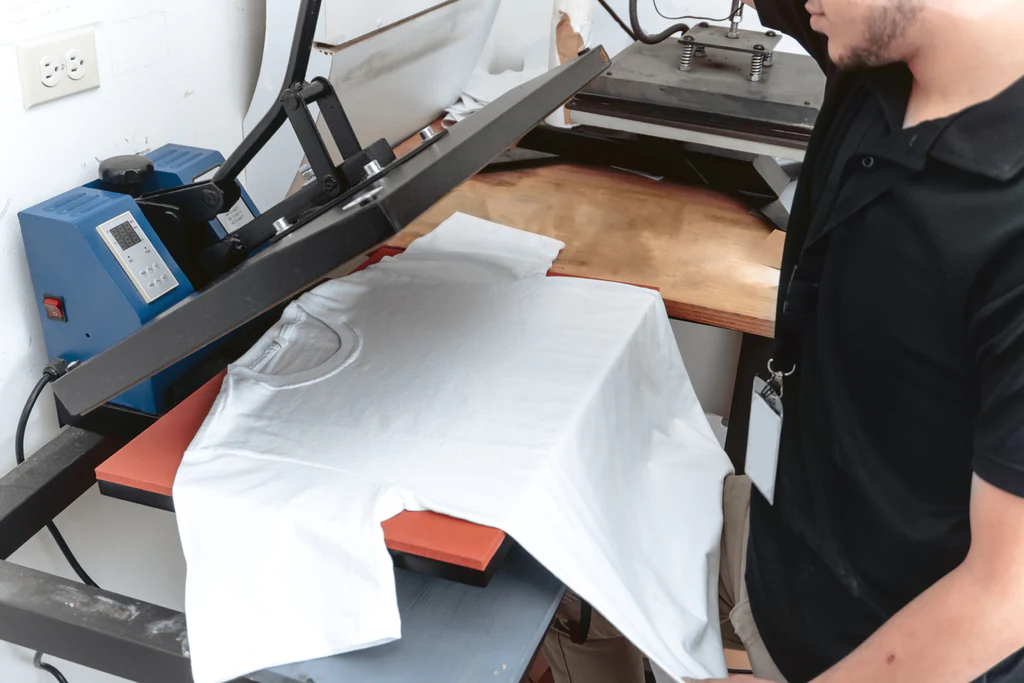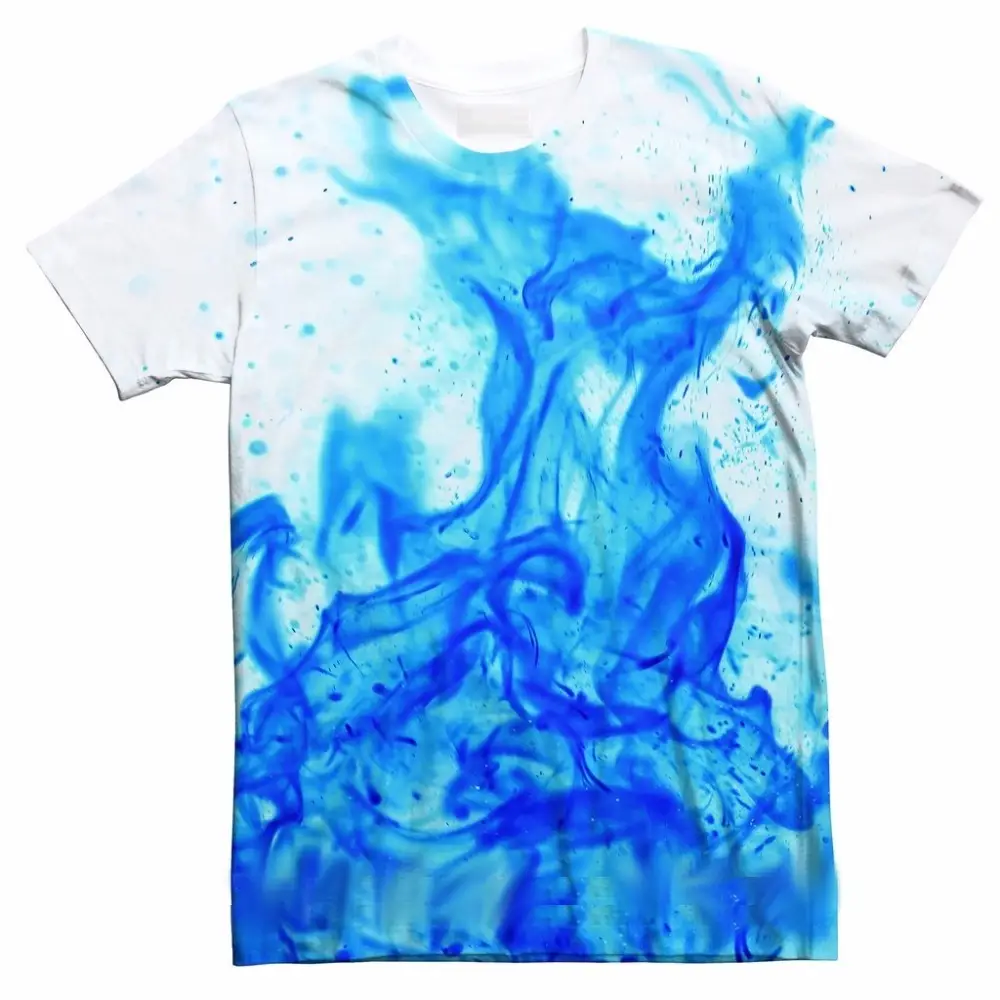In this guide, I will explain everything you need to know about sublimation printing for shirts and answer a few frequently asked questions about this topic.

What Is Sublimation, Exactly?
In specific terms, sublimation is the conversion of a substance directly from a solid state to a gaseous state.
It only happens at specific temperatures and pressures, and it does not go through the usual liquid state.
This is a broad term used to describe the solid-to-gas conversion and only describes the physical transition in-state.
What is Sublimation Shirt Printing?
Sublimation shirt printing is referred to as a specific process of printing.
It first has to do with printing onto a special sheet of paper, and afterward, the image is transferred onto another material, which is normally polyester or a polyester mix.
With that being done, the ink is then heated until it decomposes into the fabric.
In comparison with other methods, the process of sublimation printing for shirts costs more.
However, it’s more durable, and it will not crack or peel over time like other shirt printing methods.
How to Sublimate a Shirt
Well, now that you know what exactly sublimation is and what sublimation printing for shirts means, we can now move into the tutorial on how you can sublimate a shirt.

Below are the laid-out instructions on how to go about it:
The first step in this process is to create or download a design in software, much like Procreate, Photoshop, or Silhouette Studio.
After that, you are to proceed by printing the design onto sublimation paper using sublimation inks in your sublimation printer.
You also need to ensure that you mirror it. With that being done, you can now preheat your heat press.
Make sure you follow the directions on the heat press. Mine is 365 degrees Fahrenheit for T-shirts.
Now, proceed to prep the butcher paper pieces. You should be aware that one will be needed at the bottom of the press.
There should also be one between the item and the heat plate.You will also want a piece of butcher paper between the shirt to ensure that the ink does not get onto the back of the shirt.
However, this is only if you are sublimating a T-shirt. When that is done, you are to place the shirt on the butcher paper on the heat press.
Then, proceed to apply the printed sublimation design on the shirt. Do this at your preferred location on the shirt.
Now, you can press with medium pressure. This should go on for 45 to 55 seconds. After that, you are to lift the press and remove the butcher paper and sublimation design.
However, you need to ensure that this is done carefully. Now, let the shirt cool a little bit; after that, you can remove it from the heat press.
How Long Do Sublimation Shirts Last?
It has been stated above that they are more durable, but if you want a more specific and detailed answer, this is it in this section.
The truth is that sublimation prints will never discolor, wear out, or crack and peel.
That is to say that a sublimation-printed shirt will last as long as the polyester fabric can sustain it.
There are also many factors that determine the life expectancy of a polyester tee, such as how often you wash it.
But, normally, these shirts will still look vibrant and colorful even after ten years of use.
In comparison with other types of designs, the reason sublimation prints are more durable has to do with the chemical bonding process that attaches dye particles in a gaseous state to the fibers of the fabric deep beneath the surface of the shirt.
Other design methods, such as screen printing or HTV, have the same great durability.
But both of these methods have the whole design on the surface of the shirt, which in the end will probably crack or fade.
What Kind of Fabric Is Best for Sublimation?
There are usually three choices to use for making a printed T-shirt when it comes to fabric, and they include blended, polyester, or cotton:

Blended
Blended fabrics are likely to have 50% cotton, 25% polyester, and 25% rayon. They are also not a good choice of fabric for sublimation.
And this is thanks to the fact that they possess a high cotton content. Furthermore, the sublimation process does not work well on blended fabrics.
Polyester
Polyester is a man-made polymer that typically refers to polyethylene terephthalate (PET).
It is ideal for the sublimation process, thanks to the fact that the ink works best on artificial materials.
Cotton
You need to know that there are three kinds of cotton. And they include ringspun, standard, and combed.
All of these types of cotton are created from vegetable fibers that are woven into yarn and finally spun into fabric.
However, sadly, cotton is not a good choice of fabric when it comes to sublimation, as the process does not work well with natural fibers.
Best Sublimation Designs
When creating the design for your t-shirt, I strongly suggest that you consider everything.
You need to make sure that your design is a good fit for this method if you intend to use sublimation as your printing method.
Sublimation printing, as previously stated, is excellent for designs that cover the whole shirt.
Sublimation is your best bet if you intend to use a repeating pattern such as a striped, Hawaiian-patterned, or polka-dotted shirt.
Sublimation printing works well for t-shirt designs that use lots of bright colors, and this is thanks to its versatility.
If you are working with sublimation designs that are huge, complex, dramatic, and creative, then it is an excellent method.
Before you dive right into it, I strongly suggest that you ensure that your design works well with sublimation.
This is because it is possible that a different printing method would be more appropriate.
For instance, it will be wiser to go with direct-to-garment printing rather than sublimation printing if you want to create just a one-off design or a small, simple logo.
Final Thoughts: Sublimation Printing for Shirts
There are six main pieces of equipment that will be required for sublimation printing, and they include T-shirts or fabric, design software, transfer paper, sublimation ink or dye, a sublimation printer, and a heat press.

A workspace will also be required, as this is where you can store all of your equipment and securely print your t-shirts.
For a workspace, you can just set aside a space in your office, garage, or basement. That will do the work.
Now, this will be the conclusion of this guide on “Sublimation Printing for Shirts,” as you have everything you need to know about it.



